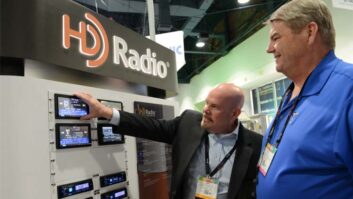It is billed as “the most advanced broadcast facility in North America.” And Corus Entertainment’s brand-new Corus Quay broadcast and content center on Toronto’s waterfront is entirely IP-centric.

Corus Quay consolidates the Toronto radio, national television and web operations of Corus Entertainment on the Toronto waterfront. Photo by Richard Johnson Three radio stations, 24 television services and numerous websites are centralized on a massive server farm and fiber-optic network. The telephone system is voice over IP; the radio stations use Wheatstone audio-over-IP technology to produce and distribute their signals.
“We built this facility to support not just what we do today, but also what we might do tomorrow,” says Corus Chief Technology Officer Scott Dyer. “With the IP infrastructure that we have installed, there is plenty of headroom for growth in an IP-driven world.”
Why Corus Quay?
Corus Quay is a eight-story low-rise built by the city of Toronto and leased by Corus as the primary tenant. The building employs advanced environmental features, including reduced power consumption, a five-story- bio-wall for air filtration, a “green” roof and energy-efficient lighting. The plumbing system uses low-flow toilets and collected rainwater to help reduce its demands on the public water supply.
Jack Diamond, principal at Diamond+Schmitt Architects, designed the building to achieve LEED Gold status.
Why did Corus decide to consolidate its Toronto-based radio, national television and Web operations in this location?
“We had grown over the last 10 years through acquisitions, which means we ended up with 1,100 employees working at 11 locations across Toronto,” said Dyer. “Not only did this not allow for effective sharing of personnel and facilities, but it created challenges fostering a unified culture.”
The Corus Quay facility solves these problems. Staff work together in an open concept environment that includes some fun elements like a circular enclosed slide in the central atrium that delivers people quickly to the ground floor.
“I have gone down the slides in my suit and tie,” said Dyer. “It is important to show that both management and staff use gravitationally assisted transportation.”

A three-story slide speeds movement within the building. ‘It is important to show that both management and staff use gravitationally assisted transportation,’ Scott Dyer said. Photo by Richard Johnson Technological advances
Corus Quay brings the company’s stations and services onto a common IP platform that is simple to provision and service. The heart of the technology infrastructure, implemented by Siemens IT Solutions and Services, is in the second-floor Technical Services room that connects to all of its studios.
“It is equipped with HP BladeSystem ProLiant and HP StorageWorks servers. These servers are linked using 600 kilometers [about 370 miles] of fiber-optic cabling managed by Cisco Nexus routers. The result is a very secure, extremely fast IP infrastructure that is both powerful and flexible.”
The radio, television and Web operations share a common storage pool and network. A storage pool of more than 2 PB is available for radio, television and IT operations at Corus Quay.
To help further reduce electrical demands, the server farm is set up as virtualized servers, where a server’s resources are divided by software so that it can act as many virtual servers. This has reduced the number of actual servers onsite by more than 90 percent, dropping the electrical consumption of its data center by more than 40 percent.
Similarly, workstations have been virtualized, so that all programs run off the network, and all documents and audio and video files are accessible from any point on the network. This allows staff to move about the facility, making use of the 155 meeting rooms and 250 other spaces for gathering and collaborating.
The Corus facility uses Cisco TelePresence videoconferencing suites here and in its offices across Canada. This allows executives to meet without having to travel. The VOIP system is provided by Cisco, as are more than 150 Wi-Fi access points throughout Corus Quay.
Radio at Corus Quay
Corus operates three stations in Toronto: classic rock station Q107; talk station AM640, and new rock station 102.1 The Edge.
Collectively, the stations use eight Wheatstone Evolution 6 control surfaces, two Evolution 4 control surfaces, nine Evolution 6 VMI-E Virtual Mixer Interfaces and 12 Glass E Remote Control Surface Software bundles.

Photo courtesy Wheatstone/Kelly Parker Digital audio is routed using two WheatNet 4864s (48-port TDM switches) in a dual-redundant configuration. They connect to six 22-position Wheatstone Bridge I/O frames and twenty 10-position Bridge Satellite I/O frames, resulting in a 1,000-by-1,200 audio I/O matrix and 552-by-552 GPI logic matrix. Audio over IP connectivity from the TDM routing matrix is provided by four ip88 Audio I/O Blades from the WheatNet-IP product line.
According to Wheatstone, this is the first installation of a Bridge-based system integrating E-Series control surfaces into a TDM platform.
Besides being cutting-edge, the Corus Quay studios are large enough to allow for live performances by small ensembles. Canadian rocker Gowan (now lead singer of Styx) was the first artist to perform live in the Q107 studio during Kim Mitchell’s afternoon show. Mitchell was one of the founders of ’70s rock band Max Webster.
“To let our fans see their DJ heroes up close and personal, we have located all three stations plus a fourth backup facility at ground level in our northwest corner,” said Scott Dyer. “This makes it possible for fans to watch our people in action through plate-glass windows.”
The spot is especially audience friendly as the city of Toronto built Canada’s Sugar Beach Park, named for the nearby Redpath Sugar facility on Lake Ontario, beside Corus Quay. The beach has sand, umbrellas and comfortable Muskoka chairs for people to relax in.
“Add the fact that we pipe our audio outside, and this is a wonderful spot to relax and watch radio take place,” Dyer said.
Corus Quay has raised the profile of Corus Entertainment in Toronto.
“Before, we were standalone stations and services; now we are a destination that people visit,” Dyer said. But the new facility also has made this company uniquely suited to face whatever IP-driven media advances will come. “We call ourselves ‘the most advanced broadcast facility in North America.’ That’s no idle claim: We have the technology and the equipment to back it up.”







